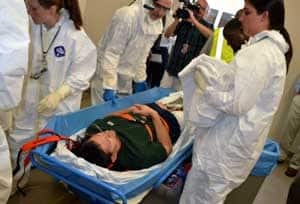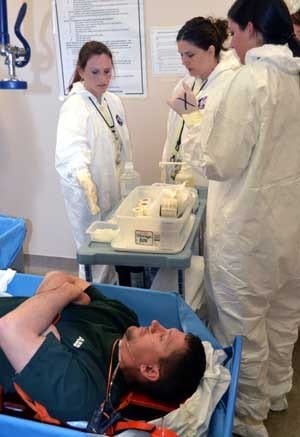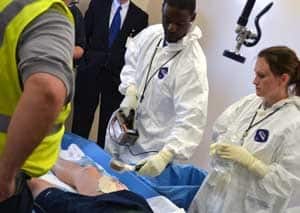UAMS Drills for Radiation Injuries
April 15, 2011 | “We’re all clear.” Those three words brought a successful conclusion to a biennial University of Arkansas for Medical Sciences’ (UAMS) drill to ensure safety and efficiency during the treatment of radiation injuries. One of just two medical centers in the state equipped to handle a radiation injury, the UAMS staff worked swiftly and efficiently under the watch of evaluators from the Federal Emergency Management Agency. “With all of the different things we see happening in the world today, this drill seems especially relevant and even more significant than in years past,” said Ron Crane, emergency preparedness manager at UAMS. “Like a lot of the things we run drills for with our staff, we hope to never have to use this knowledge. But you want to be as prepared as possible should we get a call like we did today.” That hypothetical call entailed an injured Entergy worker at the company’s nuclear reactor near Russellville. The patient arrived at the UAMS Emergency Department in a plastic body bag to keep any radiation contained. He was then transported into a specialized room with its own entrance flanking the ED. The specially designed room is equipped to handle such delicate emergencies. “The goal in this room in this case is to neutralize as much of the radiation threat as possible before bringing the patient into the hospital for further treatment,” Crane said. “Any harmful substance can be contained by our specially trained staff and specialized equipment in here so it doesn’t become a threat to other patients and doctors upon transfer inside the ED.” The UAMS team worked on the patient’s leg laceration and removed radiation from the wound by cleansing it with several solutions. Constantly changing gloves and other exposed equipment, the staff routinely measured theoretical radiation levels with several different tools. Jon Palmer, M.D., an emergency medicine physician at UAMS, led the team through the drill. “There are several scenarios we don’t see every day, and some we don’t see at all,” Palmer said. “But that’s not to say that a situation like this wouldn’t arise. By keeping our knowledge of these situations fresh with drills like these, we’re ready for whatever might present itself at any given time.” Once Palmer signaled “all clear,” the patient was moved to a new bed and transported into the ED for further treatment of his wound.
|


